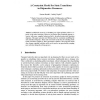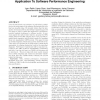65 search results - page 2 / 13 » Role Activity Diagrams as Finite State Processes |
CSCLP
2006
Springer
13 years 9 months ago
2006
Springer
Abstract. Traditional resources in scheduling are simple machines where a capacity is the main restriction. However, in practice there frequently appear resources with more complex...
ICCD
1995
IEEE
13 years 9 months ago
1995
IEEE
– This paper describes a new technique for extracting clock-level finite state machines(FSMs) from transistor netlists using symbolic simulation. The transistor netlist is prepr...
ADC
2004
Springer
13 years 10 months ago
2004
Springer
Workflow technology has met with success in a variety of industries, although several limitations have emerged. One such drawback is the inflexibility of specification languages, ...
ICDCSW
2005
IEEE
13 years 11 months ago
2005
IEEE
Although a self-stabilizing system that suffers from a transient fault is guaranteed to converge to a legitimate state after a finite number of steps, the convergence can be slow ...
WOSP
2004
ACM
2004
ACM
From UML activity diagrams to Stochastic Petri nets: application to software performance engineering
13 years 10 months ago
Over the last decade, the relevance of performance evaluation in the early stages of the software development life-cycle has been steadily rising. We honestly believe that the int...


